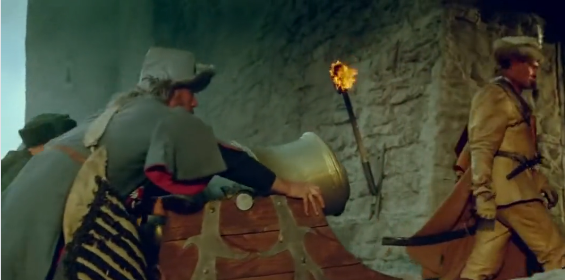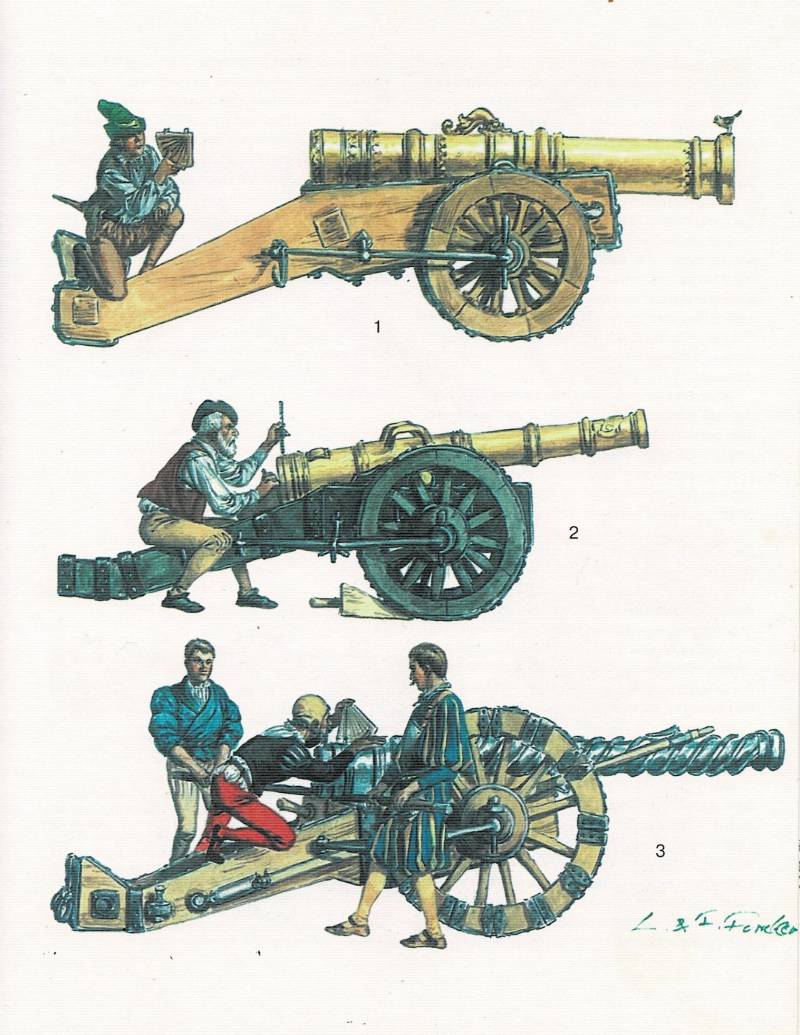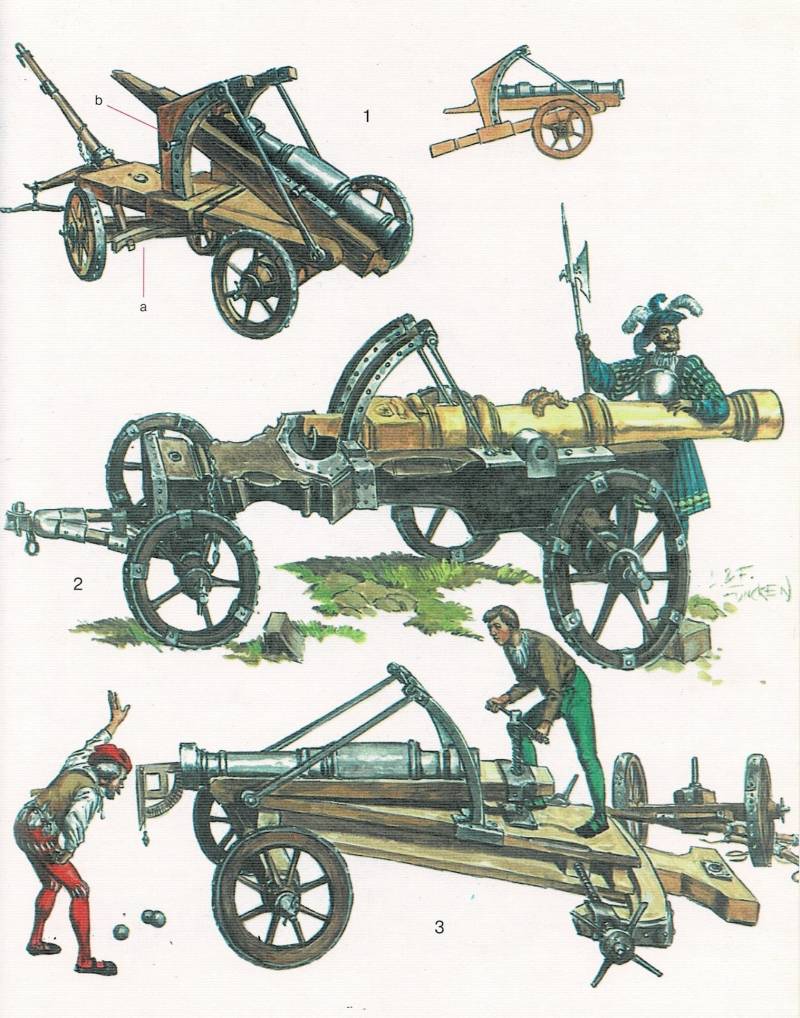Artillery of the Renaissance by F. and L. Funken

Transportation of heavy guns at that time was a big problem. But the same mortars rolled for a short distance on wheels attached to their carriages. Frame from the film "Pan Volodyevsky" (1969)
thunder and earthquake
and with a strong voice, a storm and a whirlwind,
and the flame of an all-devouring fire.
Exodus 29:6
Artillery Museum. In previous articles on stories artillery of the Middle Ages and the beginning of the New Age, we got acquainted with a number of documents of that era and, accordingly, with their interpretation by historians, including the Englishman Ian Heath. "For the completeness of happiness" we lack only a historian or historians of the French. But in this case, this is not a problem, since there is a book by Fred and Liliana Funken dedicated to the military of the Renaissance - infantry, cavalry and artillery.
However, nothing of the kind that we have already talked about here, they did not write in their book. However, this work is interesting for its illustrations, with which we will introduce our VO readers today.
The fact is that they were all made on the basis of sources of that time. That is, the Funkens simply redrawn certain artillery pieces from old books in a modern manner of presentation. However, this does not in the least detract from the value of these drawings, since they are made very scrupulously and exactly correspond to the images in ancient folios.
And today we will consider the illustrations of these authors, dedicated to the artillery of the transitional period from the Middle Ages to the New Age, already knowing quite a lot on this topic from previous materials. So…

"Artillerymen, more precisely the sight ..."
This illustration shows how the gunners of the XNUMXth century carried out aiming. After all, even then the firing range of some guns exceeded two kilometers. And at this distance it was necessary to accurately measure the angle of inclination of the gun barrel.
The sights on the gun barrels themselves were extremely simple: a triangular recess on the muzzle extension and ... everything, but the elevation angle of the barrel could be determined using a quadrant (Fig. 1, 3) or even using a rail with divisions (Fig. 2), which was placed on the breech of the barrel. However, many gunners fired "by eye", trusting their experience and eye.

Artillery new and old
In this illustration, as we can see, F. and L. Funken used as a source the “Book of Arms” by Maximilian I (which we have already talked about here), compiled by Bartholomew Freisleben. In particular, this applies to the upper figure 1, in which two arrows are controlled with an arquebus of enormous size. It's called a miracle armory technique of 1505 - "double arquebus" (doppelhakebüchse), and it was served by two arrows. The caliber of such a gun could be 25–30 mm. That is, she fired a bullet the size of a walnut.
But figure 2 is a clear evidence of the inertia of thinking. This is a cast bronze, but at the same time breech-loading cannon of 1570 with a retractable breech and wedge locking. Usually breech-loading were earlier guns, forged from iron strips fastened with hoops. It didn’t make much sense to make cast bronze guns breech-loading, but they were still made, despite the fact that it was not very convenient to use them, and even dangerous due to the strong breakthrough of gases through the shutter. Such guns lasted the longest on ships, as they saved deck space. But even at sea, by the XNUMXth century, they were replaced by “muzzle-loaders”.

Barrels and carriages
Interestingly, although the guns of that time were very simple and did not even have trunnions (or maybe just because of this!), Their carriages were much more complicated than later guns of the XNUMXth and even XNUMXth centuries.
Here is the gun of 1460 (Fig. 1), and what a complex double carriage with a screw mechanism is on it. That's what the lack of trunnions led to! Multi-barreled "organ cannon" (Fig. 2), late 30th century. It has a rotating triangular "drum" with alternately firing barrels, of which there are XNUMX pieces on it! The axis is also a barrel, but of a larger caliber.
"Shrimp" - an English twin gun with a shield of 1544 (Fig. 3). She was rolled at the enemy, and periodically fired. A seven-barrel gun of the 4th century and again with a complex carriage (Fig. 1500). But this heavy gun of 5 also does not have trunnions, but a sliding carriage was invented to point the barrel, however, only two positions (Fig. XNUMX).

Guns with an arc guidance mechanism
The disadvantages of just two positions for pointing the barrel were obvious. And in order to increase its variability, two iron arcs with holes were installed on the gun carriages, into which a pin was inserted that passed through the wing of the gun barrel. The number of barrel lift positions depended on the number of holes in which the pin was fixed!
For example, Figure 1 shows a 1500 cannon with a limber (a) and two arches with a rack (b) for nine (!) Positions. Before firing, the front was retracted, the trunk of the carriage was placed on the ground, and ... they fired, raising or lowering the barrel and fixing it in the holes on the arcs.
But this weapon of 1518 (Fig. 2) was clearly redrawn by F. and L. Funken from the painting “The Battle of Orsha”, a fragment of which we cited in the previous material. Only now they added a soldier with a halberd, and so everything is redrawn "one to one"! Well, this cannon of 1520 (Fig. 3) is a vivid evidence of the creative imagination of the master artillerymen of that time. It is equipped with mechanisms for both vertical and horizontal guidance. Moreover, aiming from it is carried out using a goniometer with a plumb line!

Carriages: more and more perfect
It is interesting that in the same 1520 there were guns, the gun carriages of which were equipped with special boxes for accessories, that is, it was quite possible to say about them: “I bring everything with me” (Fig. 1). Under Emperor Maximilian, it was customary to paint gun carriages black and red. Before us is one of these tools, the drawing of which, again, was made according to the “Book of Arms” by Maximilian I.
The design of the Maximilian gun (Fig. 3) with a richly decorated bronze barrel is interesting primarily because it has three barrels and a wooden trough with a spatula. Three barrels contained sulfur, saltpeter and charcoal, from which the powder mixture was prepared right during the battle in a wooden trough! It is clear that these ingredients were somehow measured out, but it was still quite difficult to get a uniform composition, especially in a hurry. That is why the cores often flew sometimes not at all where they needed to, since a charge of one volume could differ greatly from shot to shot!
Only by the end of the 4th century did field tools, for example, the faucon cannon (Fig. XNUMX), begin to resemble their descendants of the XNUMXth–XNUMXth centuries. During transportation, all accessories were mounted on a gun carriage!

Mortars
The previous material talked about how much horses were required to transport heavy tools of the 1510th-1th centuries. The transportation of just one cannon often represented a whole convoy, for which sometimes more carters were needed than gunners. For example, a mortar of XNUMX (Fig. XNUMX), which was transported, for example, together with two cores, required a team of six horses and, in addition, three drivers.
The vertical guidance system was quite complex and included a ratchet mechanism, which made it possible to fix the previously adjusted barrel elevation angle (Fig. 2). Again, a protractor was used, depicted lying at the gun carriage. The cores for mortars were made of stone longer than for other tools. But already in 1550 they began to be cast from cast iron, and together with lugs on the body, which made it easier to lift and lay them in the barrel. Then they thought of explosive bombs, which became a real nightmare for the besieged.
It is also interesting that the tools of that time and, in particular, the same mortars, from century to century only ... were simplified! So those mortars from which they fired in the Crimea during the siege of Sevastopol and on the battlefields of the Civil War in the United States differed only from the guns of the 3th century (Fig. XNUMX) in that they were made of cast iron and steel and had metal, and not wooden carriages!
That is, the genesis of the Renaissance artillery once again convinces us that "it is difficult to do - very simple, but to do simply - very difficult." So it is not surprising that the early artillery systems of that time were more difficult than the subsequent ones, and not vice versa.
PS
As a source of illustrations, the 2002 Astrel / AST publication was used: Fred and Lilian Funken “The Middle Ages. The era of the Renaissance: infantry - cavalry - artillery.
Information